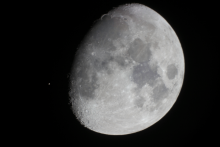Listen to today's episode of StarDate on the web the same day it airs in high-quality streaming audio without any extra ads or announcements. Choose a $8 one-month pass, or listen every day for a year for just $30.
You are here
Moon and Aldebaran
The only known planet of the star Aldebaran is a furnace. But that might not always have been the case. A recent study, in fact, says the planet could have spent billions of years in the zone that’s just right for life.
The difference is the result of changes in Aldebaran. Today, the star is nearing the end of its life, so it’s puffed up to giant proportions. That means its known planet receives so much energy that it’s far too hot for living organisms.
For billions of years, though, Aldebaran was much smaller and fainter than it is now — similar to the present-day Sun. The new study says that, under those conditions, the planet probably was in the habitable zone. That’s the distance from the star where temperatures are just right for liquid water, which is a key ingredient for life.
The planet, which was discovered by astronomers at McDonald Observatory, likely is a giant ball of gas much like Jupiter, the giant of our own solar system. Such worlds are considered unlikely homes for life. But if the planet has any moons, they could have been more comfortable — perhaps providing good conditions for life for billions of years.
And Aldebaran appears near our own moon the next couple of nights. The orange eye of Taurus, the bull, stands to the lower left of the Moon this evening. The Moon moves closer to it later on. And Aldebaran will stand even closer to the Moon tomorrow night.
Tomorrow: a dangerous approach.
Script by Damond Benningfield



